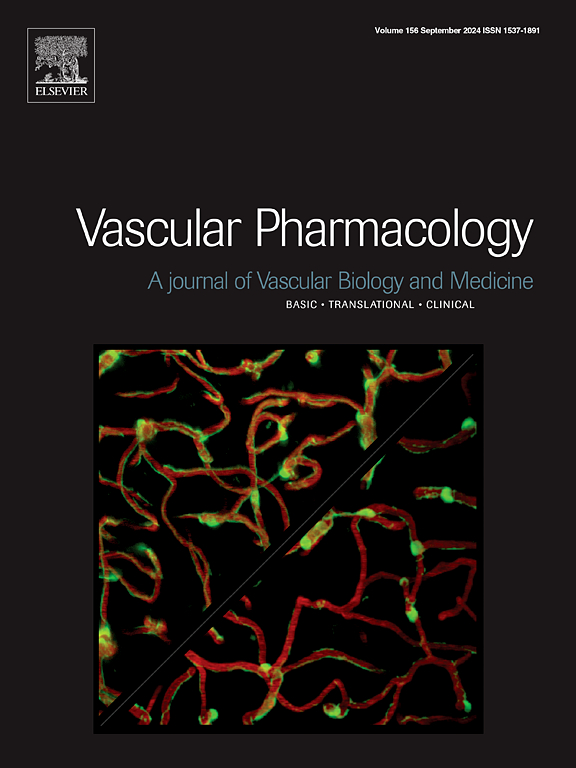糖蛋白IIb/IIIa抑制剂在选择性PCI中的应用——随机试验的系统回顾和荟萃分析
IF 3.5
3区 医学
Q2 PHARMACOLOGY & PHARMACY
引用次数: 0
摘要
糖蛋白IIb/IIIa抑制剂(gpi)作为急性冠状动脉综合征的经皮冠状动脉介入治疗(PCI)的辅助治疗可改善30天的预后,但在现代支架和口服抗血小板治疗的背景下,它们在稳定性冠状动脉疾病(CAD)中的作用仍不确定。方法系统检索PubMed、EMBASE、Central和clinicaltrials.gov数据库,检索时间自成立至2022年10月。纳入了比较GPI与安慰剂在选择性PCI中的随机试验。结果包括靶血管重建(TVR)、支架血栓形成(ST)以及30天和6-12个月时TVR、心肌梗死和死亡(MACE)的综合情况。出血评估采用溶栓心肌梗死出血评分或同等评分。所有分析均采用随机效应模型。结果在筛选的2375篇摘要中,纳入了16项研究(6428例患者)。GPIs显著降低30天MACE(风险比[RR] 0.58, 95% CI, 0.39-0.86, p <;0.01;需要治疗的人数= 33),6-12个月中期MACE (RR 0.67;95% ci, 0.49-0.92;p = 0.01)和圣(相对危险度0.29,95%可信区间,0.10 - -0.83,p = 0.02)。TVR和大出血无显著差异,但小出血增加(RR 1.72, 95% CI, 1.14-2.61, p = 0.01,需要伤害的人数= 77)。元回归表明,GPIs的益处随着时间的推移而减少。结论选择性PCI术中使用pi可降低MACE和ST,同时增加小出血。观察到的益处似乎随着时间的推移而减弱,强调了在低出血风险患者中选择性使用的重要性。本文章由计算机程序翻译,如有差异,请以英文原文为准。

The use of glycoprotein IIb/IIIa inhibitors in elective PCI – A systematic review and meta-analysis of randomised trials
Background
Glycoprotein IIb/IIIa inhibitors (GPIs) improve 30-day outcomes when used as an adjunct to percutaneous coronary intervention (PCI) in acute coronary syndromes, but their role in stable coronary artery disease (CAD) remains uncertain in the context of modern stents and oral antiplatelet therapy.
Methodology
A systematic search of PubMed, EMBASE, Central and clinicaltrials.gov databases was conducted from inception to October 2022. Randomised trials comparing GPI to placebo in elective PCI were included. Outcomes included target vessel revascularisation (TVR), stent thrombosis (ST) and a composite of TVR, myocardial infarction and death (MACE) at 30-days and 6–12 months. Bleeding was assessed using Thrombolysis In Myocardial Infarction bleeding score or equivalent. A random-effects model was used for all analyses.
Results
Of 2375 abstracts screened, 16 studies (6428 patients) were included. GPIs significantly reduced 30-day MACE (risk ratio [RR] 0.58, 95 % CI, 0.39–0.86, p < 0.01; number needed to treat = 33), intermediate-term MACE at 6–12 months (RR 0.67; 95 % CI, 0.49–0.92; p = 0.01) and ST (RR 0.29, 95 % CI, 0.10–0.83, p = 0.02). There was no significant difference in TVR or major bleeding, although minor bleeding was increased (RR 1.72, 95 % CI, 1.14–2.61, p = 0.01, number needed to harm = 77). Meta-regression suggested that the benefit of GPIs has diminished over time.
Conclusion
GPI use during elective PCI reduces MACE and ST whilst increasing minor bleeding. The observed benefit appears to have waned over time, highlighting the importance of selective use in patients at low bleeding risk.
求助全文
通过发布文献求助,成功后即可免费获取论文全文。
去求助
来源期刊

Vascular pharmacology
医学-药学
CiteScore
6.60
自引率
2.50%
发文量
153
审稿时长
31 days
期刊介绍:
Vascular Pharmacology publishes papers, which contains results of all aspects of biology and pharmacology of the vascular system.
Papers are encouraged in basic, translational and clinical aspects of Vascular Biology and Pharmacology, utilizing approaches ranging from molecular biology to integrative physiology. All papers are in English.
The Journal publishes review articles which include vascular aspects of thrombosis, inflammation, cell signalling, atherosclerosis, and lipid metabolism.
 求助内容:
求助内容: 应助结果提醒方式:
应助结果提醒方式:


